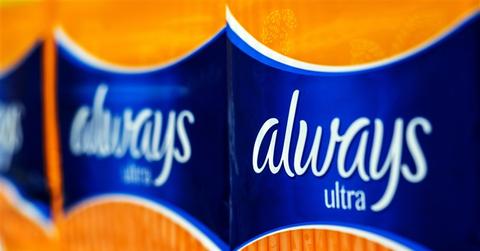
Igor Golovniov / LightRocket via Getty Images file
Why Always Removing the Female Symbol On Products Caused Uproar
By Patrice GillespieOct. 24 2019, Updated 9:49 p.m. ET
Since 1983, Always has produced feminine hygiene products that range from maxi pads to feminine wipes under their parent company Procter & Gamble. They’re mission has always been toward the overall betterment and hygiene of women and girls. However, on Wednesday Always made headlines as the company decided to remove the female symbol from its packaging to be inclusive of transgender and nonbinary customers. According to CNN, “transgender activists and allies had publicly urged Procter & Gamble to redesign its pad wrapper without the gender symbol, a circle atop a cross. Among their arguments were that not all people who menstruate are women and that not all women menstruate.”
Social media went in a frenzy, as majority of their consumers feel as though this is another slap in the face for women all over the world.
The debate on whether or not this was necessary made its way to Instagram as well. Customers have flooded the comment sections of blog posts on whether or not they agree with the brand’s decision:
To better understand the frustrations of myself, and many other women in the world, let’s break it all down, shall we? The basic definition of a woman is an adult female human; the word dates back to about the 8th century. The noun “female,” dates back to the early 14th century. The definition of female, according to the Marriam-Webster dictionary, is of, relating to, or being the sex that typically has the capacity to bear young or produce eggs. The adjective “feminine” pertains to a woman or girl.
As you may notice here, there is a recurring theme around each definition, as they seem to consistently revert back to one another. I completely understand that there are people who were born with female parts, but identify as male. There are also those who were born with male parts, but identify as female. However, one thing remains certain; whether or not you identify as a female, menstrual products are for those with woman/female/feminine parts. Inclusivity is very important, but when it comes down to menstruation, there’s only one party that should be included; those who were blessed with the ability to menstruate.
I’m sure the edification of this information may ruffle some feathers. I’m also sure that some may read this and call me ignorant. But as a 23-year-old Black woman, I often wonder when will we ever have something just for us? Why does inclusivity mean ripping off the very symbol that embraces and empowers the very reason we purchase feminine hygiene products anyway? Why does inclusivity mean putting down one party to uplift another?
If I’ve gathered anything from 2019 it’s that this country is not for anyone Black. Add the fact that you’re female, and you… I… we no longer exist. So, I’m sorry but I do not support a brand, once again, undermining the beauty of what makes us female. We’re barely hanging on, and I refuse to allow a hyprocritcal brand to eradicate us and our symbol from existence.
-Inclusivity- the practice or policy of including people who might otherwise be excluded or marginalized, such as those who have physical or mental disabilities and members of minority groups.
Inclusivity- the practice or policy of including people who might otherwise be excluded or marginalized, such as those who have physical or mental disabilities and members of minority groups.
If you have the female parts needed to use feminine hygiene products such as pads and tampons, are you not included in the mission for brands such as Always? Are you not represented, through identification or biology, via the symbol?

